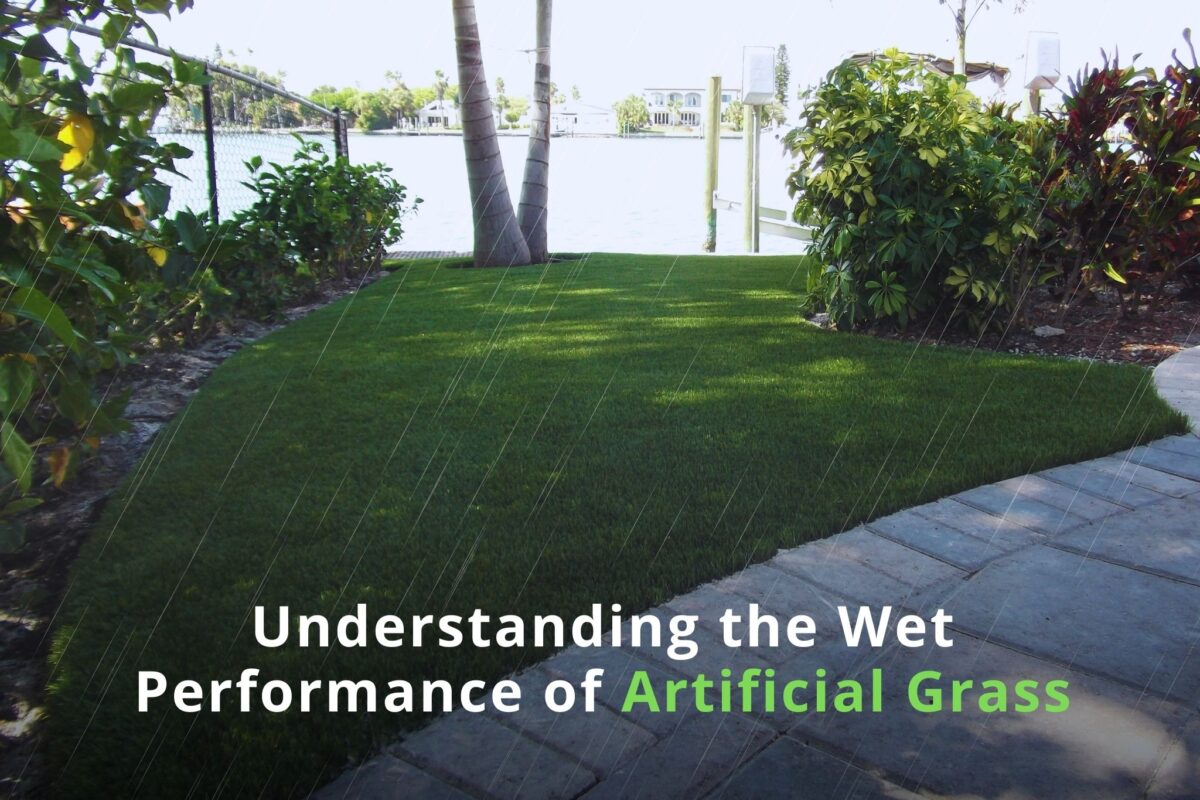- BACKYARD
- COMMERCIAL
- ENVIRONMENT
- FIELD TURF NEWS
- GOLF
- MAINTENANCE
- NEWS
- PETS
- POOL
- RESIDENTIAL
- TURF TIPS
What Happens When Artificial Grass Gets Wet?

Water Resistance and Drainage
For FieldTurf Landscape artificial grass for yards, we use advanced materials like polyethylene or polypropylene, which are resistant to moisture. The roots of artificial grass are typically a perforated backing that allows rainwater to drain away from the surface into an aggregate subsurface base below.
In turn, this base is made up of small stones that further facilitate drainage so water does not pool on or beneath your faux grass. As a result, artificial lawns drain significantly faster than natural grass and dry within a few hours after rainfall. Excessive moisture is detrimental to real lawns, but it runs right through synthetic varieties without any trouble.
Slip Resistance
You may worry that wet artificial turf could become slippery and hazardous like other hard surfaces. However, quality synthetic turf for backyard use is designed with slit film and curly fibers to ensure reliable traction even when soaked. The perforations in the backing also allow water to drain away instead of pooling on the surface. So you can rest assured that your artificial lawn will remain slip-resistant for pets, kids, and adults regardless of the weather.
Odor and Mold Prevention
Standing water can lead to foul odors and mold growth on natural grass. Thankfully, the superior drainage of backyard artificial turf prevents the moist, humid environment that spurs these issues. Without water pooling beneath it, synthetic grass doesn’t provide the necessary conditions for mold development.
Certain infill materials like antimicrobial acrylic sand and rubber are also used to resist bacterial growth and unpleasant stenches even if moisture gets trapped. So you can be confident your artificial lawn will stay fresh and vibrant rain or shine.
Cleaning Benefits of Rain
Believe it or not, rainstorms actually help keep your artificial grass clean. The falling water washes away dust, pollen, leaves, and other small debris that accumulate on the surface. As long as the rain isn’t severe enough to cause flooding, the runoff will carry most of this debris away with it.
Once the turf dries, you can easily remove any remaining bits. You can also brush or use a leaf blower to clear debris from the base of the blades. So while rain necessitates a bit of maintenance afterward. It also saves you from more intensive cleaning down the line.
Tips for Wet Weather Care
To keep your artificial grass looking fantastic despite the weather, here are some essential upkeep tips:
- • Check Drainage: Periodically confirm that water flows through the turf backing and stone base without pooling on the surface or beneath. Contact us for help with any areas with poor permeability.
- • Brush Fibers: Use a turf groomer brush to lift matted blades and restore their upright position as needed after storms. This maintains optimal drainage and appearance.
- • Remove Debris: Pick up any leaves, branches, or other debris left on your lawn post-rainfall using a leaf rake or blower. This prevents buildup.
- • Fluff Infill: If you have infill, use a stiff brush to gently stir and fluff the materials as needed to avoid compaction from rainfall.
By properly maintaining your synthetic grass, you can keep it neat and vibrant rain or shine!
Book a FREE Consultation Today
As you can see, wet weather isn’t an issue for quality artificial grass like FieldTurf’s products, which are engineered to mimic real grass in look and feel while outperforming it in practicality. Our specialized turf systems utilize state-of-the-art materials to promote drainage and retain their lush, inviting aesthetic through any forecast.
We offer free consultations and quotes to discuss your landscape goals. Our team would be happy to answer any other questions you may have – call us at 866-352-4575 or send us a message to get started.


